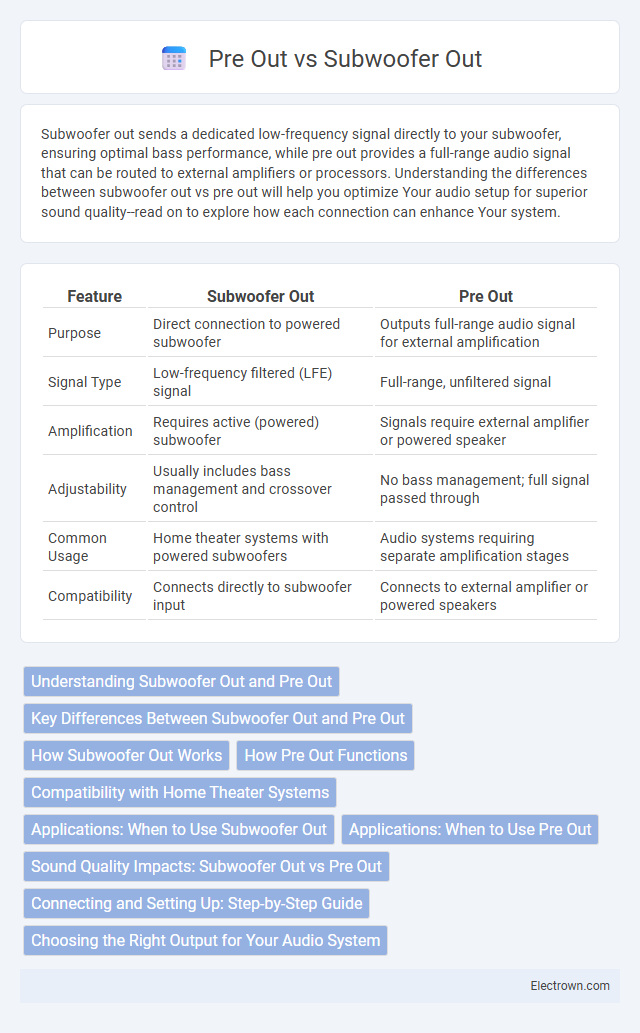Subwoofer out sends a dedicated low-frequency signal directly to your subwoofer, ensuring optimal bass performance, while pre out provides a full-range audio signal that can be routed to external amplifiers or processors. Understanding the differences between subwoofer out vs pre out will help you optimize Your audio setup for superior sound quality--read on to explore how each connection can enhance Your system.
Table of Comparison
| Feature | Subwoofer Out | Pre Out |
|---|---|---|
| Purpose | Direct connection to powered subwoofer | Outputs full-range audio signal for external amplification |
| Signal Type | Low-frequency filtered (LFE) signal | Full-range, unfiltered signal |
| Amplification | Requires active (powered) subwoofer | Signals require external amplifier or powered speaker |
| Adjustability | Usually includes bass management and crossover control | No bass management; full signal passed through |
| Common Usage | Home theater systems with powered subwoofers | Audio systems requiring separate amplification stages |
| Compatibility | Connects directly to subwoofer input | Connects to external amplifier or powered speakers |
Understanding Subwoofer Out and Pre Out
Subwoofer Out is a dedicated audio output designed specifically to send low-frequency signals directly to a subwoofer, ensuring optimal bass performance without additional processing. Pre Out provides a line-level audio signal that can be connected to external amplifiers or powered subwoofers, offering greater flexibility in audio system configuration. Understanding these distinctions helps optimize sound quality by matching the correct output type with the subwoofer's input requirements and amplifier setup.
Key Differences Between Subwoofer Out and Pre Out
Subwoofer Out is a dedicated output designed specifically to send low-frequency signals to a powered subwoofer, typically filtered to handle bass frequencies. Pre Out delivers the full-range audio signal before amplification, allowing connection to external amplifiers or powered speakers, including full-range or specialized speakers. The key difference lies in signal processing: Subwoofer Out is frequency-specific for bass management, while Pre Out provides a versatile, unfiltered signal for broader audio applications.
How Subwoofer Out Works
Subwoofer Out sends a low-frequency signal directly to your subwoofer, often filtered to deliver only bass frequencies, enhancing audio performance by offloading bass processing from your main speakers. This output typically provides a dedicated connection with a built-in crossover, allowing precise control over the subwoofer's sound without affecting other channels. Your audio system benefits from improved bass clarity and power, making it essential for home theater or high-fidelity sound setups.
How Pre Out Functions
Pre out functions by sending a line-level audio signal from your receiver or amplifier to an external device such as a subwoofer or additional amplifier, allowing precise control over sound quality and power amplification. Unlike the subwoofer out, which usually includes a built-in crossover and amplification, pre out provides an unamplified signal that requires external amplification and crossover management. This setup enhances audio customization and flexibility for audiophiles seeking tailored sound performance.
Compatibility with Home Theater Systems
Subwoofer out ports provide a dedicated low-frequency signal optimized specifically for connecting powered subwoofers, ensuring seamless integration with home theater systems without additional amplification. Pre out connections deliver a full-range audio signal that requires an external amplifier or powered subwoofer, offering flexibility but necessitating compatibility considerations with amplifiers or receivers. Home theater systems often favor subwoofer out for simplicity and optimal bass management, while pre out is preferred in setups demanding custom amplification and multi-zone audio configurations.
Applications: When to Use Subwoofer Out
Subwoofer out is primarily used to connect a powered subwoofer directly to a receiver or amplifier, providing a dedicated low-frequency signal that enhances bass performance in home theater and audio systems. This output is ideal for setups where precise bass management is needed without additional processing, such as in stereo systems or surround sound environments where the subwoofer needs to complement main speakers. Pre out, by contrast, is used when connecting to external amplifiers or processors, offering greater flexibility but requiring separate bass control solutions.
Applications: When to Use Pre Out
Pre Out is ideal for connecting external amplifiers or powered subwoofers, enabling precise control over your audio system's power and quality. You should use Pre Out when you want to expand your sound setup with high-quality components or require flexible routing for signal processing. Subwoofer Out is typically reserved for directly powering a dedicated subwoofer with built-in amplification, whereas Pre Out offers a versatile connection point for more advanced configurations.
Sound Quality Impacts: Subwoofer Out vs Pre Out
Subwoofer Out delivers a dedicated low-frequency signal optimized for bass reproduction, ensuring cleaner and more powerful sub-bass sound quality. Pre Out transmits a full-range, line-level signal that requires external filtering or processing to isolate bass frequencies, which can introduce signal degradation or phase issues if not properly managed. Choosing Subwoofer Out often results in more precise bass integration and improved overall sound clarity in a home audio setup.
Connecting and Setting Up: Step-by-Step Guide
To connect a subwoofer using the subwoofer out, plug the dedicated subwoofer RCA cable from the receiver's subwoofer out port to the subwoofer's input, ensuring a direct and optimized low-frequency signal path. When using the pre out for subwoofer connection, connect the pre out RCA cables from the receiver to the subwoofer's input, which allows for adjustable crossover settings and volume control from the receiver. After physical connections, access the receiver's setup menu to configure crossover frequency, LFE level, and output settings to match the subwoofer specifications for balanced and powerful bass reproduction.
Choosing the Right Output for Your Audio System
Subwoofer out delivers a dedicated low-frequency signal, simplifying the connection to your subwoofer and ensuring optimal bass performance. Pre out provides a full-range audio signal that allows for more flexible external amplification and integration with various components in your audio system. Choosing the right output depends on your setup needs, with subwoofer out ideal for straightforward bass enhancement and pre out suited for advanced sound customization.
subwoofer out vs pre out Infographic

 electrown.com
electrown.com